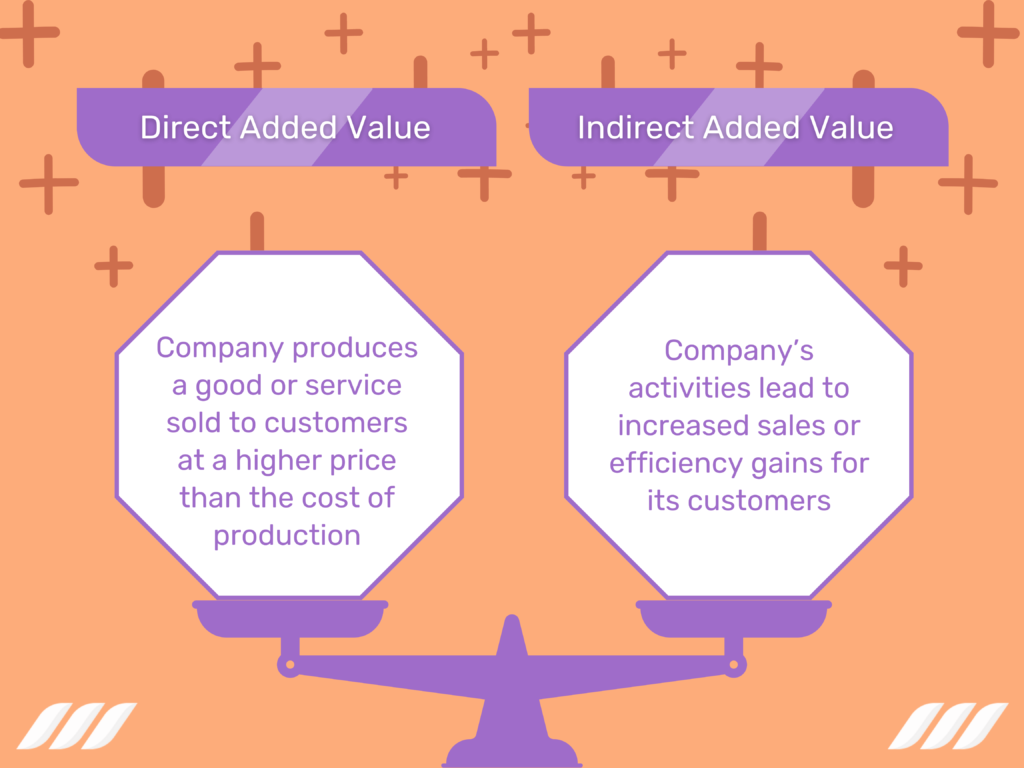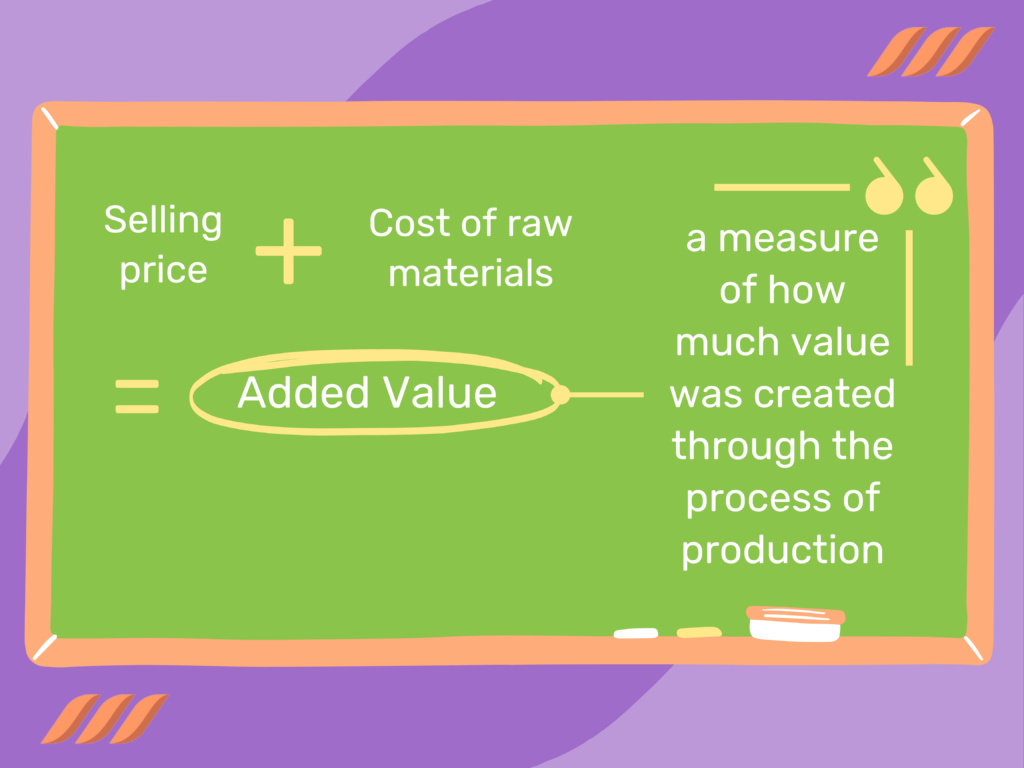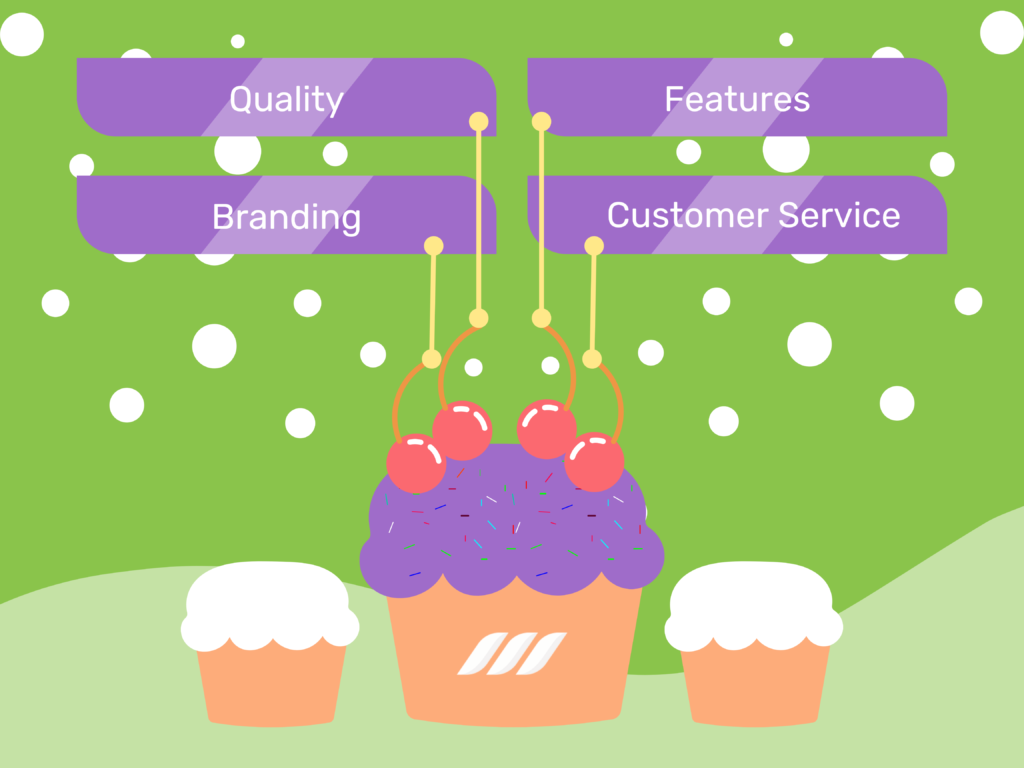|
Getting your Trinity Audio player ready...
|
In today’s business world, price is not the only determining factor for customers to buy your product or service. Today’s savvy customers are ready to pay a premium price for the extra value a product or service offers. This has opened a window of opportunity for businesses to grow sales by offering more value to customers.
Added value in business helps you stand out from the competition and reel in new customers. But what exactly is the added value? In this detailed guide, we’ll explain what added value is and explore various ways a business can leverage added value to supercharge its growth.
What is Added Value in Business?
In economic terms, added value is the difference between the price of a good or service and the cost of production. It is the measure of the economic value that a company creates for its shareholders.
A brand can generate this value in multiple ways, including product development, marketing, and efficient operations. When a company generates added value for its shareholders, it is said to have created shareholder value.
This concept is often used as a metric for assessing the performance of publicly traded companies. Take, for example, a small gadget. It might not be worth much, but if you can add value by packaging it uniquely or providing outstanding customer service, suddenly, that widget becomes economically valuable. The same is true for any product or service.
But there’s more to added value than just the price and product cost variation. Adding value to your business means finding ways to make a customer’s experience better and more memorable. It also means putting their needs above yours as a business owner.
The key to increasing your company’s value by understanding who your ideal customer is and what they need from you. Once you understand their needs, you can tailor products or services accordingly to boost your company’s value.
Read also: What Is a Buyer Persona and Why Is it Important
There are two main types of added value in business: direct and indirect. Here’s a quick rundown of these value addition types:
- Direct added value is created when a company produces a good or service sold to customers at a higher price than the cost of production.
- Indirect added value is created when a company’s activities lead to increased sales or efficiency gains for its customers. For example, if a company provides consulting services that help its clients increase sales, it has generated indirect added value.

Shareholder value represents the financial return that shareholders receive from investing in a company. On the other hand, the added value represents the economic benefits accruing to all economic participants due to a company’s activities.
Added value also helps companies create jobs and produce goods that solve major societal problems. By generating added value, companies contribute to the economy’s overall efficiency.
How is Added Value Calculated?

The equation for calculating added value in business is simple: take the selling price of a good or service and subtract the cost of the raw materials used to produce it. The result is the added value, which represents the portion of the selling price attributable to the work of the company or individual who produced the good or service. In other words, it’s a measure of how much value was created through the process of production.
In other words, it’s a measure of how much value was created through the production process. Essentially, it means you procure inputs like raw materials and then add value to them to draw customers. It’s like making a cake – you start with a base (flour, sugar, eggs), then add your special ingredients to make it your own. In business, added value often makes one product or service better than another.
For example, if two companies are selling the same product, the one offering added value like free shipping or a money-back guarantee is likely to get more sales. Added value can also be intangible, such as better customer service or a positive brand image.
While the equation may be simple, calculating added value can be complex. This is because, to calculate the added value accurately, all of the costs associated with production must be considered.
These costs can include direct costs (such as the cost of raw materials) and indirect costs (such as overhead expenses). Once all of these costs have been accounted for, only then can the actually added value be determined.
What are the Types of Added Value?

Now that you know what added value in business is, let’s explore the main types of added business value that can help take your company to new heights.
1. Quality Added Value
Quality value is the value that a product or service adds beyond its functional value. In other words, these are the extras that make a good product great or exceptional. Quality value can come in many forms, from design and aesthetics to customer service and after-sales support.
A strong brand identity lets businesses charge premium prices for their products and services because consumers perceive branded products as being of higher quality. Companies also create quality value by focusing on customer satisfaction. Businesses can encourage customers to return and recommend their products to others by delivering a high-quality product or service.
A good example of quality value is Apple’s iPhone. The iPhone’s functional value is a functional mobile phone, but its quality value comes from its sleek design, easy-to-use interface, and a powerful ecosystem of apps and accessories. This quality value has helped make the iPhone the most popular smartphone brand in the world.
Another example of quality value is Tesla’s customer service. Tesla goes above and beyond to ensure customers are happy with their purchases, offering 24/7 support and complimentary charging at Tesla stations. This level of customer service is rare in the automotive industry, and it’s one of the things that makes Tesla stand out from the competition.
2. Environmental Added Value
Businesses are adapting their operation to become more environment-friendly because of the hue and cry over the effects of global warming or climate change. Environmental value considers how a company’s activities affect the natural world.
This can include everything from emissions and waste production to resource consumption and land use. By considering the environmental value of their operations, businesses can make more sustainable choices that protect the planet.
Environmental added value can take many forms, from reducing pollution and waste to promoting sustainable practices. For example, a company might switch to using recycled materials or renewable energy sources. Or it might implement policies to reduce carbon emissions. By taking steps to protect the environment, companies can deliver value to their shareholders and make a positive difference in the world.
3. Cultural Value
Cultural value is a product or company’s intangible, emotional appeal to consumers. It is often associated with factors such as a brand’s history, reputation, and values.
For example, a luxury watch may have cultural value for its craftsmanship, whereas a fast-food restaurant may have cultural value for its affordability and convenience.
Cultural value is often difficult to define and quantify, but it can be a powerful driver of customer loyalty and brand equity. In this highly competitive marketplace, businesses that create a strong sense of cultural value for their customers are well positioned to gain a competitive edge.
What’s more? In a global market, cultural value can be the difference between success and failure. It’s not enough to offer a good product or service; you must also be sensitive to the culture of your target market.
For example, a company that sells swimwear in Brazil would need to consider the country’s unique relationship with the beach. In many ways, the beach is at the heart of Brazilian culture, and a successful swimwear company must reflect that in its products, advertising, and overall brand identity.
4. Cause-Related Value
Beyond the financial bottom line, businesses can also create value by serving a higher purpose or supporting a social cause. This is known as cause-related value and can be a powerful way to engage customers and make a lasting impression.
At its core, cause-related value aligns your business with a worthy cause. This could be anything from environmental sustainability to local charities. By associating your business with a positive message or mission, you can tap into consumers’ growing desire to support brands that reflect their values.
For example, a company that manufactures eco-friendly cleaning products is not only providing a valuable product but also contributing to the cause of reducing the negative impact on the environment.
Similarly, a business that provides financial support to a local community organization is giving valuable products and helping build strong social bonds within the community. Cause-related business value is about more than just profit; it’s about making a positive difference in the world. And that’s something that everyone can get behind.
Of course, simply attaching your brand to a cause is not enough. To create a true cause-related value, your business must be committed to making a difference. This means putting your money where your mouth is and taking concrete steps to support the causes you care about.

Why is Added Value Important for a Business?
Value is at the heart of any successful business. Whether it’s providing a great product or service, offering competitive prices, or delivering superior customer service, businesses need to find ways to add value for their customers. Without value, a company wouldn’t exist in today’s competitive marketplace.
Take the case of a local grocery store. To bring in customers, the store must offer something people want or need. If the store only sells items that you can find at lower prices elsewhere, most customers will stop shopping there.
It is a good idea for the store to add value by offering a convenient location, a wide selection of items, and helpful staff. These are things that customers are willing to pay for and that make the store a valuable part of the community.
What Are The Benefits of Added Value?
So, what exactly are the benefits of added value? Or how can businesses capitalize on added value? Let’s have a look!
1. Increased Customer Satisfaction

When a business provides added value through its products or services, it helps improve customer satisfaction. In other words, the goal is to give customers more than they expect and, in doing so, create a loyal base of repeat customers.
An excellent example of this can be seen in the airline industry. For many years, airlines competed by offering low fares and little else in the way of amenities. But, as fares became more standardized, airlines began to focus on creating added value for their passengers.
Today, most major airlines offer a wide range of services beyond simply getting passengers from Point A to Point B. In-flight entertainment, comfortable seats, and better service have become the norm. As a result, customer satisfaction levels have increased.
2. Higher Customer Retention Rates
A business that provides value can retain its customers in the long run. This is because customers are more likely to continue doing business with a company that provides them with more value.
For example, a customer who feels they are getting a good deal on their purchase is more likely to come back and buy more than a customer who feels they paid too much for what they received.
In addition, a business that provides value to its customers is more likely to receive positive word-of-mouth reviews, which can attract new customers.
3. Improved Brand Recognition And Reputation
When you add value to your business, it improves your bottom line, brand recognition, and reputation. It’s like a domino effect: when you offer more value to your customers, they see you as a more valuable company.
And as your reputation grows, so does your reach. More people become aware of your brand and see you positively. Suddenly, you’re not just another company — you’re THE company to go to for whatever it is that you do.
Just think about it: when you deliver exceptional service or produce a high-quality product, people take notice. Your name starts circulating as a reliable source for high-quality products or services.
4. Greater Market Share
All businesses compete to increase their market share. After all, a larger market share means more customers and more revenue. One way to achieve this is by offering added value to your customers. You quickly stand out from the crowd when you provide something that your competitors don’t.
Imagine you own a small business that sells artisanal cheese. You’ve been in the industry for a few years, and things are going well. You have a loyal customer base that appreciates your handiwork.
But then, a new cheese shop opens up down the street. They offer a greater variety of cheeses, and their prices are lower than yours. You start to see your customers trickle away.
So, what strategies would you adopt? You may want to add value to your business by offering free delivery and more varieties of cheese. Now, not only do you have the same variety of cheeses as the other shop, but you’re also able to reach a broader customer base.
5. Increased Profits

A business’s reputation encompasses everything it stands for and how others perceive it. A positive business reputation can be beneficial, adding value in the form of increased profits because customers are more likely to frequent businesses they perceive as trustworthy.
Referrals also come more easily when you have a good reputation. Satisfied customers are happy to spread the word about businesses they’re happy with, which can lead to a domino effect of new business.
And when your business is known for providing quality products or services, people are more willing to pay a higher price. But it’s not just about making more money – a good reputation also gives you peace of mind, knowing that you’re doing things right and that your business is well-regarded by others. That’s priceless.
6. Efficient Use Of Resources
When you maximize the value of your resources, you free up time and money to reinvest in your business. This can help you grow your business and eventually achieve your goals.
A good example is when a company sells a product or service online. They can use the extra money to improve their website, offer better customer service, or create new products. As a result, their customers are happier, and they can make more purchases.
How is the Added Value Shared in the Market?
Goods and services are produced to be exchanged in the market for money, which is representative of the value placed on the product. The output of the production process then becomes an input for another production process, thereby adding value to the product.
This added value can be shared among the factors of production – land, labor, entrepreneurship, and capital – through wages, rent, interest, and profits. Thus, the market system is a means by which society can determine how to allocate resources to produce the goods and services it desires.
For example, a company may transform raw material into a product and share this value through the market by charging a higher price for the finished product. In this way, the market can incentivize companies to add value to their products and make them more helpful to consumers. By sharing added value like this, the market can help to encourage innovation and improve the quality of life for everyone.

Increase Added Value of Your Business [Tips]
If you want to give your brand a competitive advantage and boost its credibility, follow these tips to start value-add marketing:
- Increase your online presence: Make sure your website is up to date and easy to find, and consider investing in digital marketing.
- Develop a strong brand: Ensure your branding is consistent across all platforms and accurately represents your company values.
- Create unique selling points: What makes your business different from the competition? Make sure this is clear to customers and clients.
- Focus on customer service: Excellent customer service will repeatedly keep people returning to your business.
- Build relationships with other businesses: Partnering with complementary companies can help you reach a wider audience.
- Encourage customer loyalty: Give your customers reasons to keep coming back, such as loyalty rewards or exclusive offers.
- Collect data: Track your customers’ behavior and preferences so that you can better understand their needs and create added value accordingly.
- Create a positive workplace culture: Happy employees will lead to a positive working environment, which will be reflected in your business.
- Make sustainability a priority: Consumers are looking for environmentally friendly and ethically sound businesses. So, be sure to adapt your strategies accordingly.
- Give back to the community: Supporting local causes can help to endear your business to the community and generate good PR.
Read also: How to Convert Leads Into Customers
What is Added Value in Marketing?

In marketing, added value is the difference between a product or service’s perceived benefits and perceived costs. In other words, added value as a marketing strategy involves all the extra factors that make a customer choose one product or service over another. Many factors can contribute to marketing added value, including quality, features, branding, and customer service.
An excellent example of added value in marketing is Apple’s iPhone. The perceived benefits of the iPhone include its sleek design, user-friendly interface, and wide selection of apps. The perceived cost, on the other hand, is the phone’s price.
Apple has carefully cultivated an image of luxury and exclusivity, which leads many customers to believe that the iPhone is worth the high cost. As a result, Apple has skyrocketed the value of its products, making them more attractive to potential customers.
Conclusion
In today’s fast-paced business world, it is essential to find ways to stand out from the crowd. To succeed as a business and gain customers in any market, you need to be able to demonstrate how your products give value above and beyond your competitors.
Added value is anything that makes a product or service more useful or desirable without essentially reducing its cost. It’s something special that will make customers choose your business over competitors. If you want to increase added value in your company, you need to focus on creating new ways to add value for your target audience.

![How to Write a Price Increase Letter [Tips, Examples, and Free Template]](https://dripify.io/wp-content/uploads/2021/12/27.png)
![How to Write an Effective Collaboration Email [+Templates]](https://dripify.io/wp-content/uploads/2023/05/13.png)



